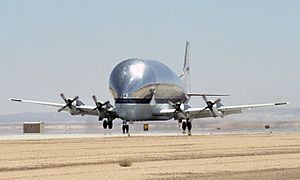Super Guppy
| B-377-SG/SGT Super Guppy | |
|---|---|
 |
|
| Super Guppy Turbine used by NASA | |
| Role | Outsize cargo freight aircraft |
| Manufacturer | Aero Spacelines / Airbus |
| First flight | August 31, 1965 |
| Status | Active, operated by NASA |
| Primary users |
Aero Spacelines NASA, Airbus, Aeromaritime |
| Number built | 1 SG, 4 SGT |
| Developed from |
C-97J Turbo Stratocruiser 377 StratocruiserPregnant Guppy (fourth one built with cannibalized pieces from Pregnant Guppy) |
The Aero Spacelines Super Guppy is a large, wide-bodied cargo aircraft that is used for hauling outsize cargo components. It was the successor to the Pregnant Guppy, the first of the Guppy aircraft produced by Aero Spacelines, which in turn was named for its resemblance to a pregnant guppy. Five were built in two variants, both of which were colloquially referred to as the "Super Guppy".
The first, the Super Guppy, or "SG", was built directly from the fuselage of a C-97J Turbo Stratocruiser, the military version of the 1950s Boeing 377 "Stratocruiser" passenger plane. The fuselage was lengthened to 141 feet (43 m), and ballooned out to a maximum inside diameter of 25 ft (7.6 m), the length of the cargo compartment being 94 ft 6 in (28.8 m). The floor of the cargo compartment was still only 8 ft 9 in (2.7 m) wide, as necessitated by the use of the Stratocruiser fuselage.
In addition to the fuselage modifications, the Super Guppy used Pratt & Whitney T-34-P-7 turboprop engines for increased power and range, and modified wing and tail surfaces. It could carry a load of 54,000 pounds (24,494 kg) and cruise at 300 mph (480 km/h).
The second version was officially known as the Super Guppy Turbine (SGT), although it used turboprop engines like the first Super Guppy. This variant used Allison 501-D22C turboprops. Unlike the previous Guppy, the main portion of its fuselage was constructed from scratch. By building from scratch, Aero Spacelines was able to widen the floor of the cargo compartment to 13 ft (4.0 m). The overall cargo compartment length was increased to 111 ft 6 in (34.0 m), and the improved fuselage and engines allowed for a maximum load of 52,500 lb (23,800 kg). These design improvements, combined with a pressurized crew cabin that allowed for higher-altitude cruising, allowed the SGT to transport more cargo than its predecessors.
...
Wikipedia
